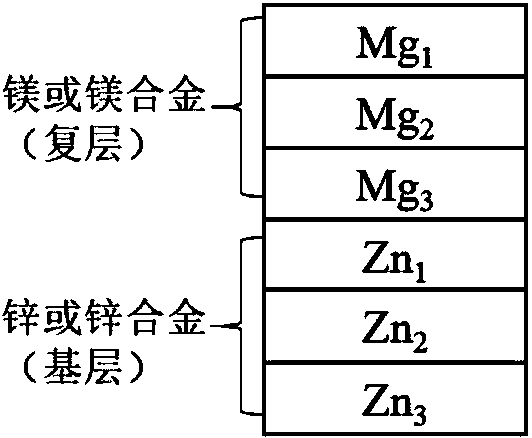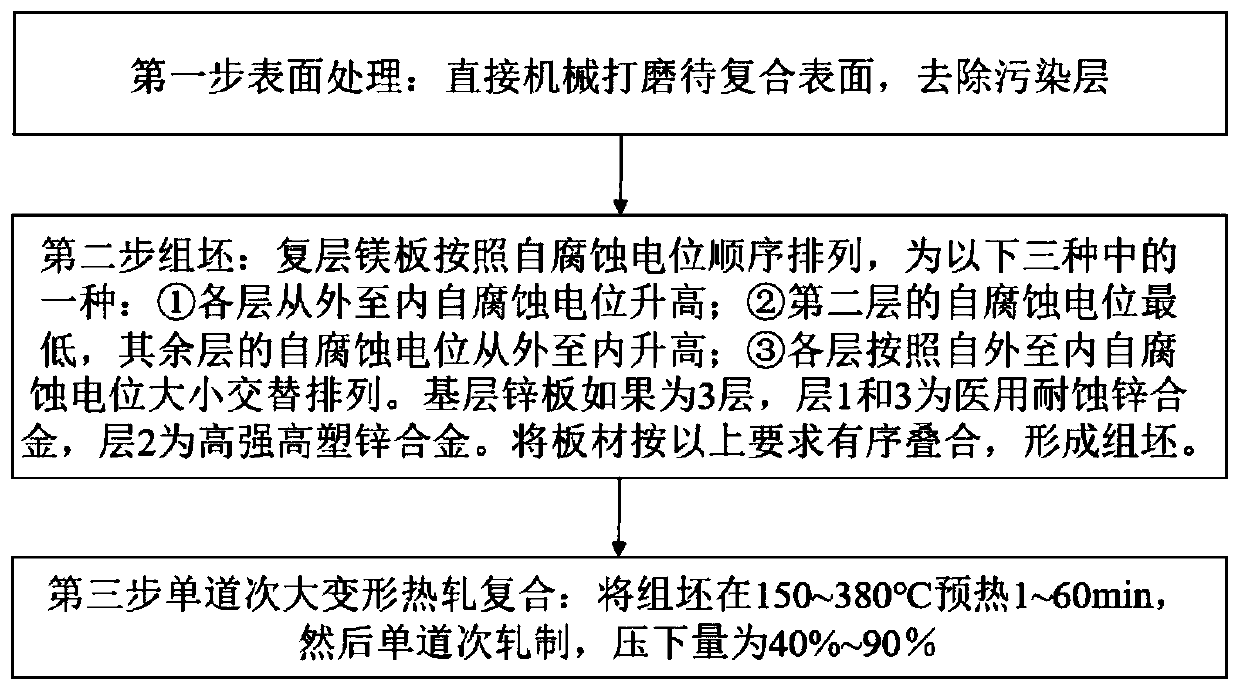Degradable multi-layer Mg/Zn composite material for medical use and preparation method thereof
A layered composite material and composite material technology, which are applied in the field of medical degradable multi-layer Mg/Zn composite materials and their preparation, can solve the problems of accelerated corrosion failure of the magnesium layer, and achieve good biocompatibility, excellent mechanical properties, Solve the effect of insufficient comprehensive performance
- Summary
- Abstract
- Description
- Claims
- Application Information
AI Technical Summary
Problems solved by technology
Method used
Image
Examples
Embodiment 1
[0030] Example 1: Design of multilayer Mg / Zn composites.
[0031] Magnesium cladding with the symbol Mg i (i=1~3) means that the zinc-based layer uses the symbol Zn j (j=1 to 3) means. The billet assembly method is one of the following four types:
[0032] ①Mg 1 / Mg 2 / Mg 3 / Zn 1 ;
[0033] ②Mg 1 / Mg 2 / Mg 3 / Zn 1 / Mg 3 / Mg 2 / Mg 1 ;
[0034] ③ Mg 1 / Mg 2 / Mg 3 / Zn 1 / Zn 2 / Zn 3 ;
[0035] ④Mg 1 / Mg 2 / Mg 3 / Zn 1 / Zn 2 / Zn 3 / Mg 3 / Mg 2 / Mg 1 ;
[0036] Mg i (i=1~3) The selection of materials is: pure magnesium, WE43, AZ91, Mg-(0.5~2)Ca, Mg-(0.5~6)Zn, Mg-(0.5~4)Cu, etc.
[0037] Zn j (j=1~3) The selection of materials is: pure zinc, Zn-(0.1~0.8)Li, Zn-(0.1~0.6)Mn-(0.01~0.1)Mg, Zn-(0.1~0.6)Mn-(0.05 ~0.3)Li, Zn-0.1Mg-0.02Ca, Zn-(0.01~20)Au, Zn-(0.5~2)Cu, Zn-(0.05~0.1)Mg-(0.5~4)Ag, Zn-( 0.01~0.2) Mg, etc.
[0038] Mg i (i=1~3) has a thickness of 0.5~1mm, that is, the total thickness of the magnesium clad layer in the billet is 1.5~3mm; Zn j (j...
Embodiment 2
[0041] Example 2: Preparation of multilayer Mg / Zn composite material and characterization of interfacial bonding state.
[0042] For the Mg / Zn composite material in Example 1, the preparation process route is: surface treatment → billet assembly → single pass large deformation hot rolling composite.
[0043] Use sandpaper, grinding wheel, wire brush or laser to polish the composite magnesium and zinc plates to remove the pollution layer and increase the surface roughness. Then the magnesium plate and the zinc plate to be compounded are stacked in order according to the sequence of Example 1 to form blanks. Put the billets in a heating furnace, preheat at 150-380°C for 1-60 minutes, and immediately carry out single-pass rolling after taking out, with a reduction of 40%-90%, to complete the compounding. After rolling, the thickness of the clad plate is 0.2-9mm.
[0044] Using a scanning electron microscope (SEM, Zeiss Merlin, Germany) equipped with an X-ray energy spectrometer...
Embodiment 3
[0046] Embodiment 3: Corrosion performance test of multilayer Mg / Zn composite material.
[0047] For the magnesium-zinc composite material prepared according to Example 2, the elastic modulus of the composite material measured according to the national standard GB / T 22315-2008 "Metallic Materials Elastic Modulus and Poisson's Ratio Test Method" is 45-60GPa. In this embodiment, the corrosion performance test is carried out according to ASTM G31-1972 (2004) "Standard Practice for Lab Immersion Corrosion Testing of Metals". The corrosion medium is simulated body fluid, and the temperature is maintained at 36.5 ± 0.5 ° C. The simulated body fluid is replaced every 24 hours. Soaked for 15-30 days. The test results show that the corrosion develops horizontally layer by layer on the surface of the inventive composite material, and the longitudinal corrosion speed is slow. As in Example 1, the design of the multi-layer magnesium cladding effectively prevents the longitudinal penetrat...
PUM
| Property | Measurement | Unit |
|---|---|---|
| elastic modulus | aaaaa | aaaaa |
| elastic modulus | aaaaa | aaaaa |
| density | aaaaa | aaaaa |
Abstract
Description
Claims
Application Information
 Login to View More
Login to View More - R&D
- Intellectual Property
- Life Sciences
- Materials
- Tech Scout
- Unparalleled Data Quality
- Higher Quality Content
- 60% Fewer Hallucinations
Browse by: Latest US Patents, China's latest patents, Technical Efficacy Thesaurus, Application Domain, Technology Topic, Popular Technical Reports.
© 2025 PatSnap. All rights reserved.Legal|Privacy policy|Modern Slavery Act Transparency Statement|Sitemap|About US| Contact US: help@patsnap.com



